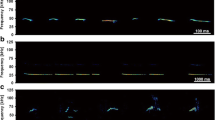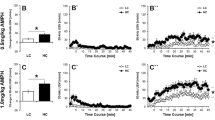Abstract
Adolescent and adult rats exhibit at least two distinct ultrasonic vocalizations that reflect distinct emotional states. Rats exhibit 22-kHz calls during social defeat, drug withdrawal, as well as in anticipation of aversive events. In contrast, 50-kHz calls are exhibited in high rates during play behavior, mating, as well as in anticipation of rewarding events. The neurochemistry of 22-kHz and 50-kHz calls closely matches that of negative and positive emotional systems in humans, respectively. The aim of this study was to replicate and further evaluate selective breeding for 50-kHz vocalization, in preparation for the analysis of the genetic underpinnings of the 50-kHz ultrasonic vocalization (USV). Isolate housed adolescent rats (23–26 days old) received experimenter administered tactile stimulation (dubbed “tickling”), which mimicked the rat rough-and-tumble play behavior. This stimulation has previously been shown to elicit high levels of 50-kHz USVs and to be highly rewarding in isolate-housed animals. Each tickling session consisted of 4 cycles of 15 seconds stimulation followed by 15 seconds no stimulation for a total of 2 min, and was repeated once per day across 4 successive days. Rats were then selected for either High or Low levels of sonographically verified 50-kHz USVs in response to the stimulation, and a randomly selected line served as a control (Random group). Animals emitted both 22-kHz and 50-kHz types of calls. After 5 generations, animals in the High Line exhibited significantly more 50-kHz and fewer 22-kHz USVs than animals in the Low Line. Animals selected for low levels of 50-kHz calls showed marginally more 22-kHz USVs then randomly selected animals but did not differ in the rate of 50-kHz calls. These results extend our previous findings that laboratory rats could be bred for differential rates of sonographically verified 50-kHz USVs.
Similar content being viewed by others

References
S. M. Brudzynski (2001) ArticleTitlePharmacological and behavioral characteristics of 22kHz alarm calls in rats Neurosci. Biobehav. Rev. 25 611–617 Occurrence Handle10.1016/S0149-7634(01)00058-6
S. M. Brudzynski (2002) ArticleTitleFifty-kHz calls induced by direct activation of the dopaminergic system in the rat brain Abstracts of the International Behavioral Neuroscience Society. 11 70
Brudzynski, S. M. (In Press). Quantitative parameters of ultrasonic communication in rats. Behav. Genet.
S. M. Brudzynski A. Pniak (2002) ArticleTitleSocial contacts and production of 50-kHz short ultrasonic calls in adult rats J. Comp. Psychol. 116 73–82 Occurrence Handle10.1037//0735-7036.116.1.73
Brunelli, S. A. (In Press). Selective breeding for an infant phenotype: Rat pup ultrasonic vocalization (USV). Behav. Genet.
J. Burgdorf B. Knutson J. Panksepp S. Ikemoto (2001) ArticleTitleNucleus accumbens amphetamine microinjections unconditionally elicit 50kHz ultrasonic vocalizations in rats Behav. Neurosci. 115 940–944 Occurrence Handle10.1037//0735-7044.115.4.940
J. Burgdorf B. Knutson J. Panksepp T. S. Shippenberg (2001) ArticleTitleEvaluation of rat ultrasonic vocalizations as predictors of the conditioned aversive effects of drugs Psychopharmacology. 115 3 5–42
J. Burgdorf J. Panksepp (2001) ArticleTitleTickling induces reward in adolescent rats Physiol. Behav. 72 167–73 Occurrence Handle10.1016/S0031-9384(00)00411-X
H. E. Covington SuffixIII K. A. Miczek (2003) ArticleTitleVocalizations during withdrawal from opiates and cocaine: possible expressions of affective distress Eur. J Pharmacol. 467 1–13 Occurrence Handle10.1016/S0014-2999(03)01558-9
G. S. Dichter S. A. Brunelli M. A. Hofer (1996) ArticleTitleElevated plus-maze behavior in adult-offspring of selectively bred rats Physiol. Behav. 60 299–304 Occurrence Handle10.1016/0031-9384(95)02222-8
C. Gentsch M. Lichtsteiner H. Feer (1988) ArticleTitleGenetic and environmental influences on behavioral and neurochemical aspects of emotionality in rats Experientia. 44 482–90
Hahn, M. E. & Lavooy, M. J. (In Press). A review of the methods of studies on infant ultrasonic production and maternal retrieval in small rodents. Behav. Genet.
M. A. Hofer H. N. Shair J. Masmela S. A. Brunelli (2001) ArticleTitleDevelopmental effects of selective breeding for an infantile trait: The rat pup ultrasonic isolation call Dev. Psychobiol. 30 231–246 Occurrence Handle10.1002/dev.1000
B. Knutson J. Burgdorf J. Panksepp (2002) ArticleTitleUltrasonic vocalizations as indices of affective states in rats Psychol. Bull. 128 961–77 Occurrence Handle10.1037//0033-2909.128.6.961
D. T. Lykken A. Tellegen (1996) ArticleTitleHappiness Is a Stochastic Phenomenon Psychol. Sci. 7 186–189
D. Mobbs M. D. Greicius E. Abdel-Azim V. Menon A. L. Reiss (2003) ArticleTitleHumor modulates the mesolimbic reward centers Neuron. 40 1041–1048 Occurrence Handle10.1016/S0896-6273(03)00751-7
J. Panksepp (1998) Affective neuroscience: The foundations of human and animal emotions Oxford University Press London
J. Panksepp J. Burgdorf (1999) Laughing rats? Playful tickling arouses high frequency ultrasonic chirping in young rodents S. Hameroff D. Chalmers A. Kazniak (Eds) Toward a science of consciousness III Mass.: MIT Press Cambridge, Mass. 231–244
J. Panksepp J. Burgdorf (2000) ArticleTitle50-kHz chirping (laughter?) in response to conditioned and unconditioned tickle-induced reward in rats: effects of social housing and genetic variables Behav. Brain Res. 115 25–38 Occurrence Handle10.1016/S0166-4328(00)00238-2
J. Panksepp J. Burgdorf (2003) ArticleTitleLaughing rats and the evolutionary antecedents of human joy? Physiol Behav. 73 533–547
J. Panksepp N. Gordon J. Burgdorf (2002) ArticleTitleEmpathy and the action-perception resonances of basic socio-emotional systems of the brain Behav. Brain Sci. 25 43 Occurrence Handle10.1017/S0140525X0247001X
J. Panksepp B. Knutson J. Burgdorf (2002) ArticleTitleThe role of brain emotional systems in addictions: a neuro-evolutionary perspective and new self-report animal model Addiction. 97 459–69 Occurrence Handle10.1046/j.1360-0443.2002.00025.x
J. Panksepp J. Moskal J. B. Panksepp R. Kroes (2002) ArticleTitleComparative approaches in evolutionary psychology: Molecular neuroscience meets the mind Neuroendocrinol. Lett. 23 IssueIDSuppl. 4 105–115
J. Panksepp S. Siviy LA. Normansell (1984) ArticleTitleThe psychobiology of play: Theoretical and methodological perspectives Neurosci. Biobehav. Rev. 8 465–492 Occurrence Handle10.1016/0149-7634(84)90005-8
R. R. Provine (2000) Laughter: a scientific investigation Viking New York
E. Scott J. Panksepp (2003) ArticleTitleRough and tumble play in human children Aggressive Behav. 29 539–551 Occurrence Handle10.1002/ab.10062
J. P. Scott J. L. Fuller (1965) Genetics and the social behavior of the dog University of Chicago Press Chicago
T. Steimer S. Fleur Particlela P. E. Schulz (2001) ArticleTitleNeuroendocrine correlates of emotional reactivity and coping in male rats from the Roman high (RHA/Verh)-and low (RLA/Verh)-avoidance lines Behav.Genet. 27 503–12 Occurrence Handle10.1023/A:1021448713665
Thornton, L. M., Hahn, M. E. & Schanz, N. (In Press). Genetic and developmental influences on infant mouse ultrasonic calling. Patterns of inheritance in the calls of mice 3–9days of age. Behav. Genet., submitted.
L. J. Vanderschuren R. J. Niesink J. M. Van Ree (1997) ArticleTitleThe neurobiology of social play behavior in rats Neurosci. Biobehav. Rev. 21 309–326 Occurrence Handle10.1016/S0149-7634(96)00020-6
Author information
Authors and Affiliations
Corresponding author
Rights and permissions
About this article
Cite this article
Burgdorf, J., Panksepp, J., Brudzynski, S.M. et al. Breeding for 50-kHz Positive Affective Vocalization in Rats. Behav Genet 35, 67–72 (2005). https://doi.org/10.1007/s10519-004-0856-5
Issue Date:
DOI: https://doi.org/10.1007/s10519-004-0856-5



